Double Star of the Month in Aquarius
-
October 2023 - Double Star of the Month
About 15 degrees north of the centre of the Square of Pegasus is a relatively sparse region of stars but it does contain some interesting doubles. Near the south end of this space is STF 3050 (see this column for October 2016) whilst four degrees further north and slightly preceding is STF 3042 (23 51 52.409 +37 53 28.4) which consists of stars with magnitudes 7.6 and 7.8 and which are currently 6" apart at PA 87 degrees. I found them to be a
delightful pair of yellow stars
whilst the entry in Sissy Haas' volume notes them asan easy white pair
.
A finder chart for the double star STF 3042 in Andromeda created with Cartes du Ciel. They likely form a long period binary as Gaia DR3 notes that the parallaxes differ by just 0.009 milli-arcsecond. The stars lie 226 light-years away and both appear white, but are contrasted against an orange star 3' to the south-east. Unrelated to STF 3042 this is the long period variable candidate V 397 And (V = 8.9) which was picked up by Hipparcos. The listed amplitude is just 0.03 magnitude, and the spectral type is M5.
Move 2.5 degrees west and slightly south to find the unequal pair STT 501. The stars are 6.5 and 10.6 and have PA 162 degrees and separation 15".
41 Aqr (22 14 18.02 -21 04 28.9) sits four degrees north of the Aquarius—Piscis Austrinus border and is just four degrees west of NGC 7293 the Helix Nebula.
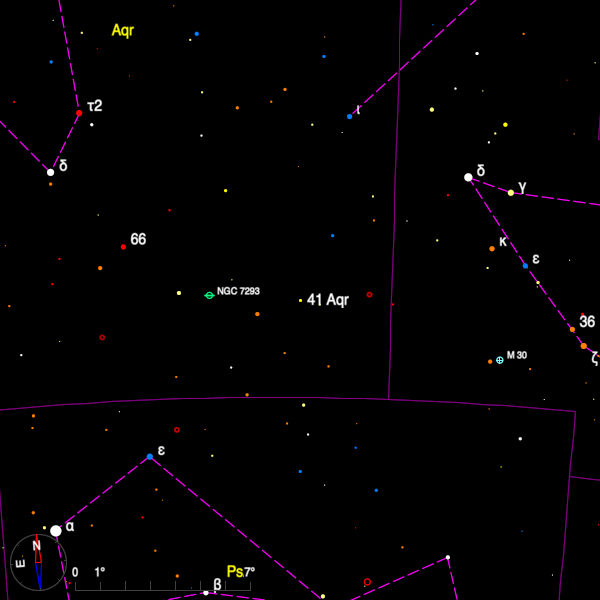
A finder chart for the double star 41 Aqr in Aquarius created with Cartes du Ciel. It is number 56 in William Herschel's third double star list and is an easy pair for the small aperture. The stars have magnitudes 5.6 and 6.7 and the primary is a KO giant; a rather ambiguous note in the Washington Double Star catalog (WDS) implies that it has a composite spectrum which is strengthened by the fact that Gaia DR3 quotes an error in the parallax about three times higher than might be expected for a star of this magnitude. The stars have similar parallaxes and proper motions and as the parallax of the companion is more precise then both stars must lie 239 light-years away.
This is a pretty pair; Smyth recorded colours of topaz yellow and cerulean blue whilst Webb noted reddish and blue and Sissy Haas yellowish-peach and pale violet.
The WDS also notes two more distant and unrelated field stars: an 8.9 at 45 degrees and 210" (C) with another fainter object of V = 11.6 12" away from C in PA 255 degrees.
Bob Argyle - Double Star Section Director
-
October 2021 - Double Star of the Month
The fine pair STF 3053 (00 02 36.1 +66 05 56) is located on the border between Cassiopeia and Cepheus and is about 1 degree south of the large emission nebula Cederblad 214. It is marked on the Cambridge Double Star Atlas 2nd Edition (CDSA2) but not labelled.
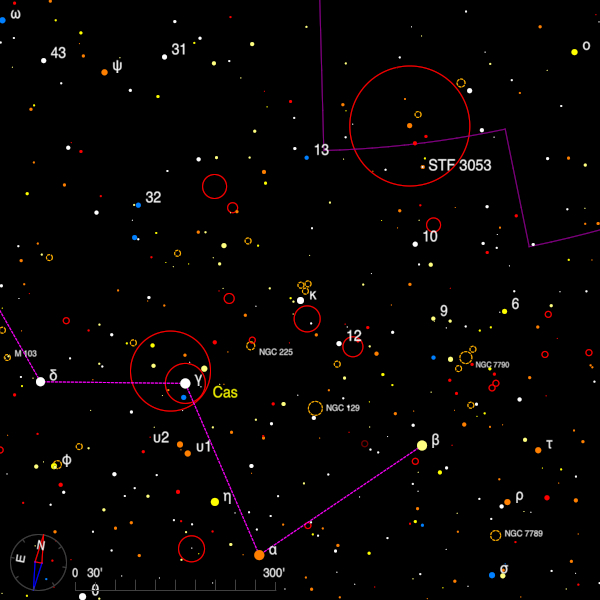
A finder chart for the double star STF 3053 in Cassiopeia created with Cartes du Ciel. This is an easy object for the small aperture with the components of magnitudes 6.0 and 7.2 currently separated by 15".2 in PA 70 degrees, although the separation has decreased from 18" over 200 years. I have not measured this pair, possibly because the high declination makes access using a German-mounted refractor awkward. There is a third star, V = 11.0, at 99" and 291 degrees.
Gaia EDR3 has pinned down the distance to all three stars, in the case of the main pair to better than 1% - the mean value is 803 light-years. The faint companion is 33 light-years further out, but with a significantly greater error.
One of the double stars which William Herschel included in his last list of discoveries is H N 112, better known as STF 3008 (23 23 45.3 -08 27 36) which lies in Aquarius and is again included in CDSA2 but again is unlabelled. It can be found as the faint point about one degree north following the three stars marked psi, and also, incidentally, one degree due west of the spiral galaxy NGC 7606.
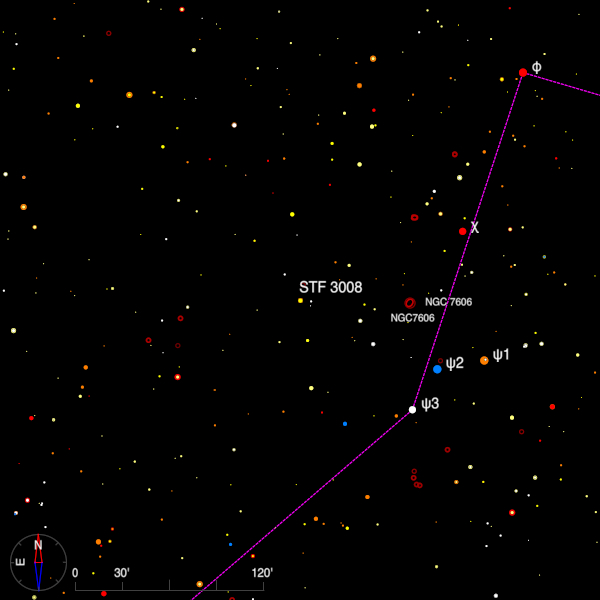
A finder chart for the double star STF 3008 in Aquarius created with Cartes du Ciel. This is certainly an optical pair but is noticeable for the measurable change in aspect over a number of years. I measured this pair with the Cambridge 8-inch three times with the following results: 2000 - 153 degrees, 5".97, 2005 - 151 degrees, 6".27 and 2014 - 149 degrees, 6".67. The stars are magnitudes 7.2 and 7.7 and easily seen in smaller apertures.
Bob Argyle - Double Star Section Director
-
October 2020 - Double Star of the Month
In this column exactly 10 years ago, the fine binary star 72 Peg was described. It remains a severe test for 20-cm aperture but as the stars are almost equally bright at V=6, so separating the components, which are now 0".59 apart, is made somewhat easier.
About 2 degrees to the north-east is another Burnham discovery, BU 858 (23 41 17.6 +32 33 40), somewhat wider than BU 720 (BU 858 is 0".8 at present) but with components whose V magnitudes are 7.8 and 8.8 this is an equally challenging pair.
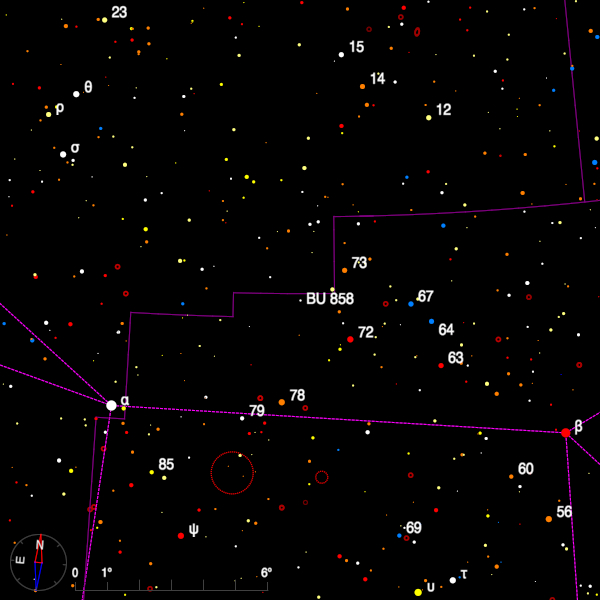
A finder chart for the double star BU 858 in Pegasus created with Cartes du Ciel. Since discovery in 1881 the companion has moved almost 60 degrees in position angle, but there is no orbit as yet. A magnitude 12.9 star at 23" is being left behind by AB and was also found by Burnham (BU 389) but earlier in his career and with the famous 6-inch refractor. Gaia DR2 does not give data on A and B but quotes a parallax for both stars of 6.66 mas, equivalent to 490 light-years. The faint star is much more distant and clearly optical.
The second edition of the Cambridge Double Star Atlas notes that tau Aqr is preceded, about 45 minutes to the south-west, by a somewhat fainter but still naked-eye star called 69 Aqr (22 47 42.7 -14 03 23). The SIMBAD catalogue also lists alternative names for tau and 69 as tau 2 and tau 1. Tau is unmistakeable - it a magnitude 4.0 star with a distinctly reddish hue - an MO giant in fact.

A finder chart for the double star 69 Aqr in Aquarius created with Cartes du Ciel. The closer pair, of which 69 Aqr is the brighter component, are separated by about 20" but this distance has been closing since 1781 when William Herschel found the stars 35".8 apart. Measures I made in 1994 and 2005 show the distance decreasing over that time interval. This is purely down to difference in proper motions as the stars are at significantly different distances. The pair is also known as STF 2943. The WDS notes that A is also a spectroscopic binary and a putative faint and distant companion found in 1918 does not exist. Herschel noted colours of reddish-white and dusky. A is a hot blue dwarf of spectral type B9 and the companion has a somewhat later spectral type, but Simbad does not elaborate.
Bob Argyle - Double Star Section Director
-
September 2019 - Double Star of the Month
STF 2744 is located in northern Aquarius (21 03 03.09 +01 31 55.9) near the border with Equuleus.
It seems to have missed the attention of William Herschel which is surprising considering that the current orbit of 1532 years gives a separation of fully 2" for 1780 and the stars are of magnitude 6.3 and 7.0. That fact and the general run of observations plotted in the United States Naval Observatory (USNO) 6th Orbit Catalogue tend to suggest an orbit of smaller angular size and orbital period. In any case observations of position angle are almost ten degrees away from the predicted position.
In 2014 I found it at 113 degrees and 1".4 and motion is slow so it should still be within the resolution range of 10-cm. Greater aperture would be needed to spot two faint field stars - one of magnitude 12.9 at 99 degrees and 98" and another of 14.3 at 300 degrees and 74". The A component does not appear in the Gaia DR2 catalogue, whilst the distance of B is given as 233 ± 5 light-years.
Lambda Sco, also known as Shaula, is the brilliant white star in the tail of the Scorpion (17 33 36.52 -37 06 13.8).
It first appeared in a double star catalogue when James Dunlop noted a magnitude 9.2 star which is currently at 330 degrees, 94" (2016). Dunlop recorded the distance as 60" but this is clearly an error. In 1897 T.J.J. See found a magnitude 14.9 star 42" distant from the magnitude 1.6 primary which has, unsurprisingly, only one observation in the Washington Double Star Catalog (WDS) since discovery.
Slipher found the bright star to be a spectroscopic binary (SB) in 1903, which has subsequently been shown to have a 6 day period, whilst the SUSI interferometer array in Australia showed that this system rotates around another star in a period of 2.9 years. The brighter member of the SB is an early B star whilst its companion is either a massive white dwarf or a TT Tau star. The SUSI companion is another early B dwarf. Like lambda, the Dunlop companion is a brilliant white star.
Bob Argyle - Double Star Section Director
-
September 2016 - Double Star of the Month
Located in Cepheus, STT 461 = 15 Cephei (22 03 53.86 +59 48 52.5) offers a stellar grouping which more resembles an asterism than a multiple star. On the basis that a picture is worth a thousand words, an image from the POSS Quick V survey is appended showing the main components of the group.
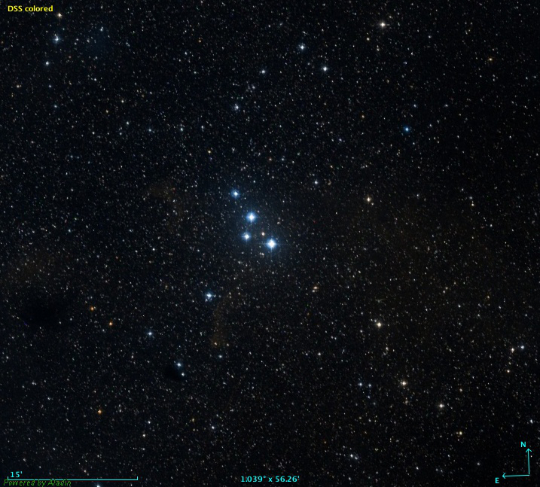
This image was provided by the Digitized Sky Survey. STT 461 is located close to the galactic equator and can be found about 2 degrees north-west of the orange supergiant zeta Cep. (mag. 3.4), the most south-easterly of the five bright stars in the pentangle of Cepheus. W. J. Hussey, who re-observed the complete STT catalogue using the Lick 36-in (1901) merely measured AB and the 9th magnitude companion C. The WDS lists eight stars to mag 14.3; the primary star is a hot B1 dwarf of magnitude 6.6 and has B (mag 11.4) 11" distant in PA 297. C which is a K0 giant is 90" away in PA 40. There is little relative motion in the group, which, if the stars are all at the same distance as A, lies about 1500 light years away.
One of S. W. Burnham's earlier discoveries (BU 172), made with the 6-inch Alvan Clark refractor, was 51 Aquarii (22 24 06.87 -04 50 13.2). At that time Burnham's telescope was not fitted with a micrometer so his friend and colleague, Baron Ercole Dembowski in Italy measured the pair for him. In 1875 the two stars were at PA 20 degrees and separated by 0".46 so offered a tough test for Dembowski's 7.5-inch refractor.
The pair then slowly closed through most of the last century, reaching a minimum distance of 0".11 around 1987 when the position angle was changing by 20 degs per year. A good set of speckle measures since then means that the orbit is now tolerably well-known. The period is 145 years and at the time of writing the separation was just under 0".5 and widening, with the companion almost at the point in the orbit where it was discovered last time around.
A good 20-cm should show the pair but its fairly low altitude means the air needs to be steady. On 1782 Oct 2, William Herschel noted three faint and distant companions to 51 Aqr, but the duplicity of the primary star, then close to its maximum separation of 0".6, escaped him.
Bob Argyle - Double Star Section Director
-
September 2015 - Double Star of the Month
Nestling in the region about 4 degrees north following the upper left-hand corner of the Square of Pegasus, AC 1 (HIP1669) (00 20 54.10 +32 58 40.9) seems to have been a little neglected by the double star community. It doesn't even have a note in the WDS catalogue but things may change now that Henry Zirm has published an orbit for it.
It was discovered by Alvan Clark using a 7.125-inch object glass of his own make in October 1856, and published in MNRAS a year later with additional notes by W. R. Dawes. At the time of discovery it was 0".4 apart and Dawes was of the opinion that it escaped the attention of F. G. W. Struve at Pulkovo because it was too close at that time.
This view has been borne out - the stars are now easily measurable with a 20-cm refractor. The magnitudes are 7.3 and 8.3. Hartung notes that the stars are 'deep-yellow' and also points out the presence of a orange-red star some 4'.5 SW (HR 59 - spectral type K5III). Zirm's orbit with a projected period of 525 years is clearly provisional as the stars are close to maximum separation and only 12 degrees has been described in the apparent orbit. The author found 289°s; and 1".9 in autumn 2014.
Psi 1, 2, and 3 Aquarii are three bright stars of visual magnitude 4.2, 4.4 and 5.0 respectively. They can be found about 3 degrees east of the centre of the line joining alpha Peg to Fomalhaut, in a region rather low down from the UK but filled with interesting visual doubles.
Some 4 degrees directly below psi 3 is 94 Aquarii (23 19 06.51 -13 27 30.4) a fine, wide pair which is worth seeking out. Its mag 5.3 and 7.0 stars appeared yellow and orange to Hartung who was able to observe them close to the zenith whilst the Reverend Webb noted a reddish glare in A whilst B appeared greenish.
The proper motion of the pair amounts to more than 0".3 per year so the fact that the change recorded in separation over 200 years amounts to only 2 arc seconds tells us that this is a physical pair, and it is located 69 light years away. In 1976 McAlister and colleagues discovered that B was a close pair (MCA 74) and it has subsequently turned out to be a binary of short period. It rotates every 6.3 years and the separation is never more than 0".2.
Bob Argyle - Double Star Section Director
-
Double Star of the Month - October 2013
In this series of short articles, a double star in both the northern and southern hemispheres will be highlighted for observation with small telescopes, with new objects being selected for each month.
Delta Cephei (22 29 10.25 +58 24 54.7) is the prototype pulsating variable the period of which holds the key to its distance. Thanks to Hipparcos this distance has also been determined geometrically and it comes out at 865 light years with a formal error of 37 light years. Regrettably few Cepheids were in range of the satellite during its operation between 1989 and 1993 but its successor, GAIA, will sweep up many more when it launches later this year. Delta is also a most attractive double star and its mag 6.1 companion is probably visible in regular binoculars. It can be found 41" distant from delta in PA 191°. This is formally star C in the system as S. W. Burnham found a much fainter (mag 13) and somewhat closer star (B) using the 18.5-inch refractor at Dearborn. Matt Heijen using a 30-cm Orion records the colours on his StarObserver.eu website and notes 'yellow, almost orange and bluish white'. There are three more distant comites between mag 13.5 and 14. C was noted as a spectroscopic binary by Belopolsky more than 100 years ago but little seems to be known about it now and it does not appear in the Ninth Catalogue of Spectroscopic Binary Orbits. Recent radio observations of delta reveal an extended nebula of ionized hydrogen surrounding the star which infers that mass loss is taking place at a level of around 10-6 solar masses per year. This may go some way to explaining the discrepancy between the mass derived from stellar evolutionary models and that obtained from stellar pulsation and dynamical techniques.
STF2944 in Aquarius (22 47 50.19 -04 13 44.8) is a nice triple star which contains a visual binary system. It is 2.5 degrees following the pretty, coarse pair kappa Aqr which has an orange primary star. The closer AB pair consists of stars with magnitudes 7.3 and 7.7 which have closed up considerably since discovery in 1782. In the same time the position angle has increased by almost 60°. For the end of 2013 the stars can be found at 303° and 1".86. C which is mag 8.6 is 60" away in position angle 86°. This is not physically connected to AB and is being left behind by the rather considerable proper motion of the close pair, some 0".4 per year. It is large enough to have attracted the attention of Willem Luyten and both components are in the NLTT (Not Less than Two-Tenths) Catalogue. The colours in these stars are not too obvious given that they are rather faint, but at low power Sissy Haas gets beige white and arctic blue for AB combined and C. Hipparcos confirms the proximity of the system to the Sun - the parallax yields a distance of 105 light years.
Bob Argyle - Double Star Section Director
-
Double Star of the Month - September 2013
In this series of short articles, a double star in both the northern and southern hemispheres will be highlighted for observation with small telescopes, with new objects being selected for each month.
As telescope makers of renown the Clarks (Alvan and his son Alvin George) were able to point large new telescopes at bright stars in order to test them and, if lucky, they discovered new companions. Such was the case of Sirius but here there was already significant evidence that the star was double based on Bessel's discovery of variable proper motion.
In the case of tau Cygni (21 24 47.35 +38 02 39.6), however, the discovery of duplicity was entirely serendipitous. Discovered by A. G. Clark using a 26-inch refractor, it has turned out to be a system of considerable interest. The period is 49.8 years and the separation varies from about 0".5 to 1".1 but the difficulty for the observer is the significant difference in brightness between the two stars. The WDS gives V mags of 3.8 and 6.6. The writer has seen the comes with the 8-inch OG at Cambridge and the system is widening again at present - in the autumn of 2013 the position will be 213° and 0".9 and so should be seen in 20-cm on a night of good seeing. The pair is easy to find as the southernmost of a trio of brightish stars 10 degrees following gamma Cygni and it is 1.5 degrees south following 61 Cygni. Recent investigations by the astrometric-based Palomar High-precision Astrometric Search for Exoplanet Systems (PHASES) have pointed out the possibility of a sub-stellar companion to one of the stars. The period may be 826 days and the mass may be 12.3 Jupiters but this is very much preliminary work.
About 10 degrees preceding the 3rd magnitude star beta Aquarii is 3 Aqr. Just south following is a pair of stars the preceding of which is 4 Aqr and the following 5 Aqr. William Herschel noted that 4 Aqr (20 51 25.69 -05 37 35.9) was double on Sept 3 1782 and listed it as number 44 is his Class I stars. Wilhelm Struve measured it at Dorpat in 1825 and at present the stars are in almost exactly in the same place having undergone a whole orbital revolution since then. This 187-year-period binary is not particularly easy from the UK due to its low declination and it is now closing again. For 2014.0 it will be at 30° and 0".7 making it a target for a superior night. The stars are mags 6.4 and 7.4.There are two distant and unconnected comites - C is 13.3 at 74" from AB and D is 9.7 at 136". In each case the separation is increasing.
Bob Argyle - Double Star Section Director
-
Double Star of the Month - September 2010
In this series of short articles, a double star in both the northern and southern hemispheres will be highlighted for observation with small telescopes, with new objects being selected for each month.
The two pairs this month are both long period binaries, whose physical association was in some doubt for many years.
zeta Aqr (22 28 49.8 -00 01 12) is not strictly a northern double star being some 72 arc seconds south of the equator but it is such a bright and easy pair for the small telescope that it is worth seeking out. It is one of the bunch of bright stars which are 5 to 8 degrees following alpha Aquarii.
The stars that form zeta are magnitudes 4.3 and 4.5 and the spectral type of early F suggests that the colour of the primary should be yellowish. Webb in 1851 finds pale yellow, Hartung also notes yellow and Sissy Haas has pale citrus-orange.
According to Thomas Lewis, Zeta was found to be double by Christian Mayer in 1777 but it does not appear in his pioneering catalogue of 80 double stars published in 1780 according to Jurg Schlimmer. William Herschel observed it soon afterwards and includes it as H II 7. At this time the companion was about 4 arc seconds due north and for most of the nineteenth century the motion appeared linear, but in the first quarter century of the twentieth century the pair closed up and the companion began to swing around A. At present the position angle and separation are 170° and 2".1 and the stars are now separating and will continue to form an easy pair for centuries to come.
53 Aqr (22 26 34.3 -16 44 31.9) can also be seen from northern latitudes but it requires a night of good seeing to separate the two stars cleanly. These are almost identical GO dwarfs of mags 6.3 and 6.4 and when the pair was first found by South/Herschel the separation was more than 10 arc seconds. Over the last 200 years the stars have slowly closed, mostly in an apparently linear fashion but about 50 years ago the companion began a slow majestic swing around the primary.
Hale in 1994 computed an orbit with a period of 3500 years so our knowledge of the binary motion is cursory at best but regular and accurate measures over the next 50 years or so will define the periastron part of the orbit. If Hale's work is right, the maximum distance between the stars will be almost 27 arc seconds in 1800 yea’s time, but as luck would have it minimum distance of 1".27 is reached in 2014, so this is a very good time to watch this pair.
Bob Argyle - Double Star Section Director